Halide Lighting
Aquarium Metal halide lighting is one of the most commonly used types of lighting by marine aquarium hobbyists. Simply put, aquarium metal halide is the closest you can get to natural sunlight. This type of lighting has proven itself for many years in the reef keeping hobby, producing beautiful light spectrum's, an amazing shimmer effect that you always hear so much about, and astounding coral growth in a properly maintained reef aquarium. Metal halides in the aquarium hobby are primarily used for reef and planted aquariums. Because these fixtures produce such intense light, it is much easier to replicate what these plants and corals are used to in nature.
The Shimmer Effect
Aquarium Metal Halide is "Source Point" lighting meaning that the source of light is coming from a single point as opposed to light spread over a large area like fluorescents produce. You can get an example of the shimmer effect by holding a flashlight over your tank pointing at the sand. You will need some surface agitation from a powerhead or pump to get the best effect. The shimmer effect adds a more natural appearance to your tank and is similar to what you would actually see if you were in the ocean looking at corals.
What You Can Keep With Halide Lighting
Halide lighting is often associated with high maintenance, high light requiring corals and anemone's, but these lights can be can be applied to almost any set up and can be used to keep any photosythetic coral. However, the reason that metal halides are so popular is because of the intensity of their light output per how much space they use. In a 2 foot area, with an aquarium metal halide, you can get up to 400 watts of water penetrating, high intensity light. To match this with T-5's, you would have to fit more than 16 24 inch tubes in that same 2 foot area.
Types Of Halide Bulbs
There are 2 main types of aquarium metal halide bulbs; SE and DE. SE = Single Ended bulb. This is the same type of bulb you see in your house with a threaded end that screws into a mogul base. DE= Double Ended bulb. This is a bulb that is connected at both ends in which the current is fired into the bulb. Generally speaking and from a hobbyist point of view DE bulbs are more efficient than SE bulbs since they are fired from both ends and don't lose energy from the threaded connection.

Picture: DE or Double ended Metal Halide Bulb

Picture: SE or Single ended Metal Halide Blub
*Important*
1. These bulbs must never be handled with bare hands. the natural oils from your finger will contaminate the glass and cause heat to gather in that area and effects the bulb. If you happen to touch it just remember to clean off any finger prints or marks and use a paper towel or tissue provided with the bulb to handle it.
2. Metal halide bulbs run very hot and you should never touch one after the bulbs has been burning for any period of time.
3. If you ever turn off an metal halide fixture, and then turn it right back on and nothing happens, don't panic. Wait a few minutes and try again - the bulb needs to be cool to fire.
4. Metal Halide bulbs should be changed every 6-8 months! As the bulbs age, their spectrum's change, which can cause algae growth, and intensities weaken, which can slow coral growth.
Halides and UV
Metal halide lighting is known to have some UV emission. While we should never be looking at the bulb itself while it is firing in your aquarium metal halide fixture or hood, your fish and corals are always exposed to this, and measures should be taken to reduce it. Over time, if the UV is not filtered, it could have some ill effects on the inhabitants of your aquarium.
That being said, most aquarium metal halide fixtures come with UV filtering shields that will reduce the amount of UV that is transmitted to your aquarium and its inhabitants. Mogul base metal halide bulbs usually have a UV filtering glass built into the bulb, and this is important because most mogul base metal halide setups are just the bulb in open air, with a reflector, right above the water in your aquarium with nothing in between. Some DE, or double ended, bulbs also have this same type of UV filtering glass, but some do not. We recommend that no matter what setup you chose, that you have some type of UV filtering glass in between your metal halide and your aquariums water just to be safe. Purchasing a protective shield like this is a small investment compared to how much you have spent on your fish, corals, and plants. Never use a plastic, acrylic, or plexiglas UV shield as the heat emitted by the metal halide will surely melt, and bend it out of shape.
Color Temperature
Metal halide bulbs come in a variety of color temperatures, but the range we typically deal with in aquariums is from 5,000k-22,000k. The lower end of the spectrum is used mainly for planted tanks as the color that is emitted is more of a white to yellowish light and resembles that of the sun. The lower end of the spectrum also has benefits in increased par (photo synthetic radiation), which is the spectral range of solar radiation that photosynthetic organisms are able to use in the process of photosynthesis. However, if you would like to use a low color temperature bulb like this on a reef aquarium, you would need to supplement the metal halide light with some type of T5 or power compact actinic lighting as it is proven that corals need some blue light to thrive.
Aquarium metal halide bulbs that are in the 10,000k+ color temperature will emit a white, crisp light, with more blue as you go up in temperature. A 20,000k bulb will emit a very blue light. Bulbs in this range do not need actinic supplementation for corals, and 14,000k is said to be the best temperature for coral growth by itself.
Set-Up
An aquarium metal halide lighting system requires a few main components to operate: A bulb, a reflector, and a ballast. The bulb will fire and emit the light, the reflector will target the light in the desired direction as well as increase the efficiency and intensity of the bulb, and the ballast is the power center that controls and powers the metal halide bulb. As far as how many watts you should have over your aquarium, you must look at the inhabitants you are currently housing, or plan to house, and choose the light that best suits their needs. There is no rule of thumb in this department as each and every aquarium setup is different in some way.
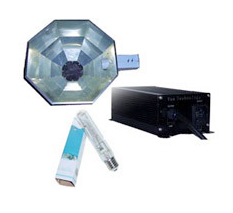
Picture: Lighting Components
Maintenance
Just like anything else in the aquarium hobby, there is maintenance that is required to keep your aquarium metal halide lighting system functioning properly. First, metal halide bulbs must be changed every 8-12 months. As halide bulbs age, their light output weakens, color spectrum's change, and overall efficiency of the bulb reduces. When the color spectrum on these types of bulbs changes, it lowers into a temperature that is perfect for growing algae, which can get out of hand very quickly. Also, as the bulbs age, their outer glass weakens due to the high firing temperature of the bulb, chemicals in the air, and movement of the bulb. This will cause problems when trying to fire the bulb and in rare cases, can even cause the bulb to explode. These bulbs must never be handled with bare hands. the natural oils from your finger will contaminate the glass and cause heat to gather in that area and effects the bulb. If you happen to touch it just remember to clean off any finger prints or marks and use a paper towel or tissue provided with the bulb to handle it. Metal halide bulbs run very hot and you should never touch one after the bulbs has been burning for any period of time. Finally, cleaning reflectors regularly is a good way to keep the efficiency of the reflector good and keep salt creep away.
Disadvantages of Halide Lighting
Aquarium metal halide lighting does have some negatives. The first and foremost concert of metal halide lighting in the aquarium keeping hobby is heat emission. Metal halide bulbs create a lot of heat and end up transferring most of this heat to the aquariums water. If you have a large tank, and you are housing multiple high wattage metal halide lamps inside your canopy, your tank will most likely raise a few degrees, and in some cases, too many degrees to keep what you want in the aquarium. However, there are ways to battle this temperature increase. The addition of supplemental cooling devices such as chillers or fans can keep the temperature low enough and stable enough to use whatever lighting you desire. Again, this really depends on your setup as each one is different in some way.
Power consumption is also a concern for a lot of aquarists who are on a budget, and housing 3, 400 watt metal halides will be expensive to power over a years time. However, depending on your setup, you can still keep an aquarium with a metal halide light system rather cheaply. If you would like to know roughly how much you are, or will be, spending on powering your metal halide light, please click here for an organized chart that does exactly that.
Metal Halide ANSI Codes
The list below provides a quick reference of most aquarium metal halide bulbs and their corresponding ballast ANSI codes.
* Base type denotes whether the bulb is single-ended (SE) or double-ended (DE).


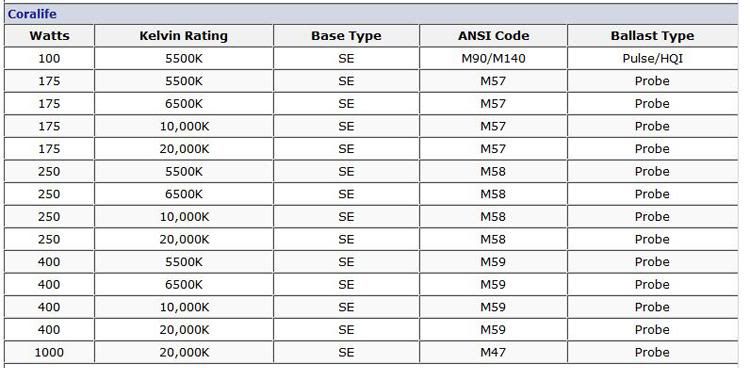


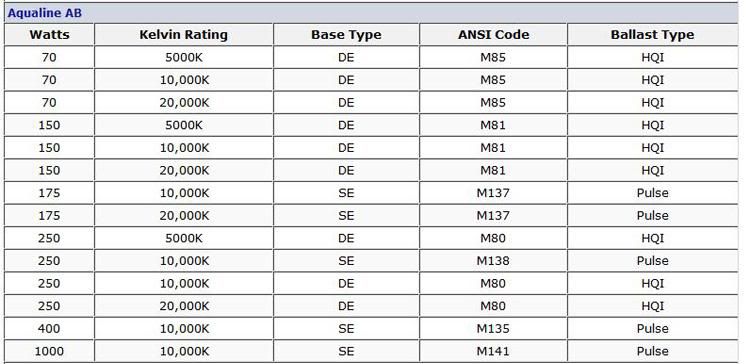
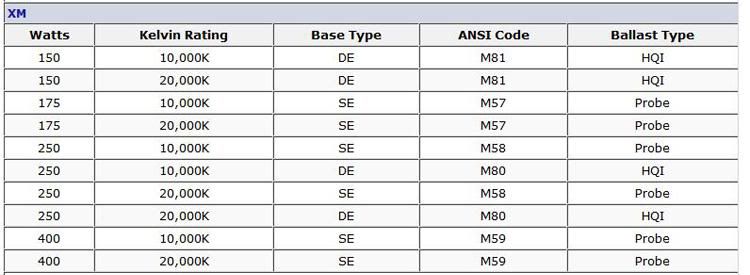
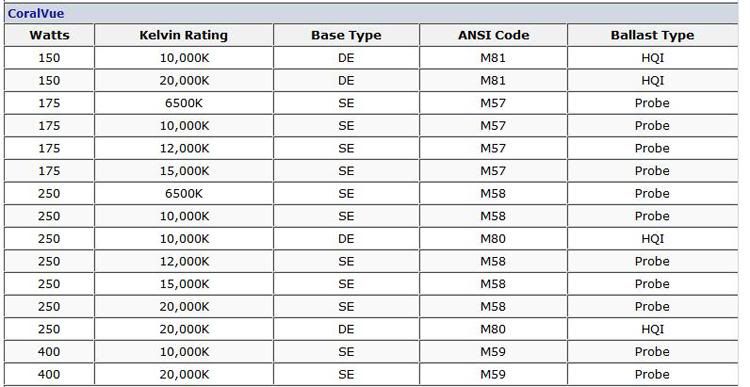

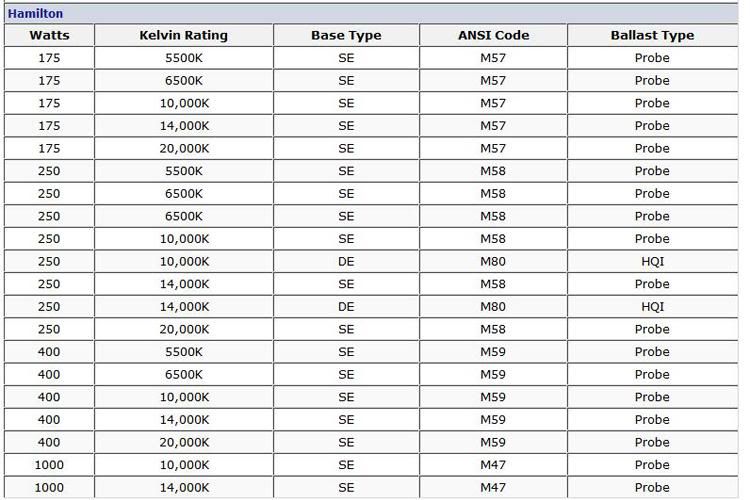

Wiring Diagram
*Warining* These drawings are examples only. Please check ballast label for correct diagram.

Green = Ground. All exposed metal (fixture and ballast case) should always be grounded.
Drawings by: Paul Erik Hirvonen from http://members.fortunecity.com/paulerik/id51.html
Aquarium Metal halide lighting is one of the most commonly used types of lighting by marine aquarium hobbyists. Simply put, aquarium metal halide is the closest you can get to natural sunlight. This type of lighting has proven itself for many years in the reef keeping hobby, producing beautiful light spectrum's, an amazing shimmer effect that you always hear so much about, and astounding coral growth in a properly maintained reef aquarium. Metal halides in the aquarium hobby are primarily used for reef and planted aquariums. Because these fixtures produce such intense light, it is much easier to replicate what these plants and corals are used to in nature.
The Shimmer Effect
Aquarium Metal Halide is "Source Point" lighting meaning that the source of light is coming from a single point as opposed to light spread over a large area like fluorescents produce. You can get an example of the shimmer effect by holding a flashlight over your tank pointing at the sand. You will need some surface agitation from a powerhead or pump to get the best effect. The shimmer effect adds a more natural appearance to your tank and is similar to what you would actually see if you were in the ocean looking at corals.
What You Can Keep With Halide Lighting
Halide lighting is often associated with high maintenance, high light requiring corals and anemone's, but these lights can be can be applied to almost any set up and can be used to keep any photosythetic coral. However, the reason that metal halides are so popular is because of the intensity of their light output per how much space they use. In a 2 foot area, with an aquarium metal halide, you can get up to 400 watts of water penetrating, high intensity light. To match this with T-5's, you would have to fit more than 16 24 inch tubes in that same 2 foot area.
Types Of Halide Bulbs
There are 2 main types of aquarium metal halide bulbs; SE and DE. SE = Single Ended bulb. This is the same type of bulb you see in your house with a threaded end that screws into a mogul base. DE= Double Ended bulb. This is a bulb that is connected at both ends in which the current is fired into the bulb. Generally speaking and from a hobbyist point of view DE bulbs are more efficient than SE bulbs since they are fired from both ends and don't lose energy from the threaded connection.

Picture: DE or Double ended Metal Halide Bulb

Picture: SE or Single ended Metal Halide Blub
*Important*
1. These bulbs must never be handled with bare hands. the natural oils from your finger will contaminate the glass and cause heat to gather in that area and effects the bulb. If you happen to touch it just remember to clean off any finger prints or marks and use a paper towel or tissue provided with the bulb to handle it.
2. Metal halide bulbs run very hot and you should never touch one after the bulbs has been burning for any period of time.
3. If you ever turn off an metal halide fixture, and then turn it right back on and nothing happens, don't panic. Wait a few minutes and try again - the bulb needs to be cool to fire.
4. Metal Halide bulbs should be changed every 6-8 months! As the bulbs age, their spectrum's change, which can cause algae growth, and intensities weaken, which can slow coral growth.
Halides and UV
Metal halide lighting is known to have some UV emission. While we should never be looking at the bulb itself while it is firing in your aquarium metal halide fixture or hood, your fish and corals are always exposed to this, and measures should be taken to reduce it. Over time, if the UV is not filtered, it could have some ill effects on the inhabitants of your aquarium.
That being said, most aquarium metal halide fixtures come with UV filtering shields that will reduce the amount of UV that is transmitted to your aquarium and its inhabitants. Mogul base metal halide bulbs usually have a UV filtering glass built into the bulb, and this is important because most mogul base metal halide setups are just the bulb in open air, with a reflector, right above the water in your aquarium with nothing in between. Some DE, or double ended, bulbs also have this same type of UV filtering glass, but some do not. We recommend that no matter what setup you chose, that you have some type of UV filtering glass in between your metal halide and your aquariums water just to be safe. Purchasing a protective shield like this is a small investment compared to how much you have spent on your fish, corals, and plants. Never use a plastic, acrylic, or plexiglas UV shield as the heat emitted by the metal halide will surely melt, and bend it out of shape.
Color Temperature
Metal halide bulbs come in a variety of color temperatures, but the range we typically deal with in aquariums is from 5,000k-22,000k. The lower end of the spectrum is used mainly for planted tanks as the color that is emitted is more of a white to yellowish light and resembles that of the sun. The lower end of the spectrum also has benefits in increased par (photo synthetic radiation), which is the spectral range of solar radiation that photosynthetic organisms are able to use in the process of photosynthesis. However, if you would like to use a low color temperature bulb like this on a reef aquarium, you would need to supplement the metal halide light with some type of T5 or power compact actinic lighting as it is proven that corals need some blue light to thrive.
Aquarium metal halide bulbs that are in the 10,000k+ color temperature will emit a white, crisp light, with more blue as you go up in temperature. A 20,000k bulb will emit a very blue light. Bulbs in this range do not need actinic supplementation for corals, and 14,000k is said to be the best temperature for coral growth by itself.
Set-Up
An aquarium metal halide lighting system requires a few main components to operate: A bulb, a reflector, and a ballast. The bulb will fire and emit the light, the reflector will target the light in the desired direction as well as increase the efficiency and intensity of the bulb, and the ballast is the power center that controls and powers the metal halide bulb. As far as how many watts you should have over your aquarium, you must look at the inhabitants you are currently housing, or plan to house, and choose the light that best suits their needs. There is no rule of thumb in this department as each and every aquarium setup is different in some way.

Picture: Lighting Components
Maintenance
Just like anything else in the aquarium hobby, there is maintenance that is required to keep your aquarium metal halide lighting system functioning properly. First, metal halide bulbs must be changed every 8-12 months. As halide bulbs age, their light output weakens, color spectrum's change, and overall efficiency of the bulb reduces. When the color spectrum on these types of bulbs changes, it lowers into a temperature that is perfect for growing algae, which can get out of hand very quickly. Also, as the bulbs age, their outer glass weakens due to the high firing temperature of the bulb, chemicals in the air, and movement of the bulb. This will cause problems when trying to fire the bulb and in rare cases, can even cause the bulb to explode. These bulbs must never be handled with bare hands. the natural oils from your finger will contaminate the glass and cause heat to gather in that area and effects the bulb. If you happen to touch it just remember to clean off any finger prints or marks and use a paper towel or tissue provided with the bulb to handle it. Metal halide bulbs run very hot and you should never touch one after the bulbs has been burning for any period of time. Finally, cleaning reflectors regularly is a good way to keep the efficiency of the reflector good and keep salt creep away.
Disadvantages of Halide Lighting
Aquarium metal halide lighting does have some negatives. The first and foremost concert of metal halide lighting in the aquarium keeping hobby is heat emission. Metal halide bulbs create a lot of heat and end up transferring most of this heat to the aquariums water. If you have a large tank, and you are housing multiple high wattage metal halide lamps inside your canopy, your tank will most likely raise a few degrees, and in some cases, too many degrees to keep what you want in the aquarium. However, there are ways to battle this temperature increase. The addition of supplemental cooling devices such as chillers or fans can keep the temperature low enough and stable enough to use whatever lighting you desire. Again, this really depends on your setup as each one is different in some way.
Power consumption is also a concern for a lot of aquarists who are on a budget, and housing 3, 400 watt metal halides will be expensive to power over a years time. However, depending on your setup, you can still keep an aquarium with a metal halide light system rather cheaply. If you would like to know roughly how much you are, or will be, spending on powering your metal halide light, please click here for an organized chart that does exactly that.
Metal Halide ANSI Codes
The list below provides a quick reference of most aquarium metal halide bulbs and their corresponding ballast ANSI codes.
* Base type denotes whether the bulb is single-ended (SE) or double-ended (DE).











Wiring Diagram
*Warining* These drawings are examples only. Please check ballast label for correct diagram.

Green = Ground. All exposed metal (fixture and ballast case) should always be grounded.
Drawings by: Paul Erik Hirvonen from http://members.fortunecity.com/paulerik/id51.html